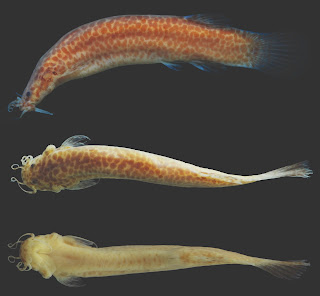 |
| Ituglanis crispim Donin, de Pinna, Severi & Ramos, 2023 |
Abstract
Trichomycterid catfishes have long been considered as absent in the Parnaíba River basin, Northeastern Brazil, in what constitutes their most conspicuous gap in geographic distribution. Herein we report on the first occurrence of the family in that basin. The new species is described from the riacho da Volta, right tributary to the upper rio Parnaíba, Piauí State. It is distinguished from its congeners by the combination of two or three pairs of ribs; 36–38 post Weberian vertebrae; a color pattern composed of round, similar-sized, non-coalescent spots; I,5 pectoral-fin rays; the first haemal arch on the 5th or 6th vertebrae; and the first completely fused (to the tip) haemal spine on the 15th vertebra. A putative autapomorphy is the partial (minimally 50% of their length) or total fusion between the anterior arms of the basipterygium. Preliminary evidence suggests that the new species can be related to northern South American forms, a pattern that fits the general Amazonian relationships of the fishes in the Parnaíba River drainage. Although the new species fills in an important qualitative gap in trichomycterid continental distribution, the taxon is apparently rare and extremely restricted in distribution, with the type series being its only record so far. The paucity of trichomycterids in the Parnaíba remains a puzzling biogeographical phenomenon.
Keywords: Ituglanis; New species; Taxonomy; Trichomycterinae
Ituglanis crispim, new species
Ituglanis sp. —Ramos et al., 2014:04
[listed to Parnaíba River basin].
Diagnosis. Ituglanis crispim is distinguished from all congeners by the combination of the following characters: two or three pairs of ribs; 36–38 post Weberian vertebrae; a color pattern composed of round, uniformly-sized, evenly-spaced, non-coalescent spots; I,5 pectoral-fin rays; the first haemal arch on the 5th or 6th vertebra; the first completely fused (to the tip) haemal spine on 15° vertebrae. The presence of two or three pairs of ribs (vs. four pairs or more) distinguish the species from all congeners with the exception of I. amazonicus (Steindachner, 1882), I. apteryx Datovo, 2014, I. compactus Castro & Wosiacki, 2017, I. eichhorniarum (Miranda Ribeiro, 1912), I. gracilior (Eigenmann, 1912), I. herberti (Miranda Ribeiro, 1940), I. ina Wosiacki, Dutra & Mendonça, 2012, I. inusitatus Ferrer & Donin, 2017, I. macunaimaDatovo & Landim, 2005, I. metae(Eigenmann, 1917), I. nebulosusde Pinna & Keith, 2003, and I. parkoi(Miranda Ribeiro, 1944). The count of 36–38 post Weberian vertebrae distinguish I. crispim from I. amazonicus, I. apteryx, I. gracilior, I. herberti, I. inusitatus, I. metae, and I. parkoi, all with 39 or more vertebrae. The pigmentation pattern composed by round, similar-sized, non-coalescent dark spots, slightly larger than eye (vs. color patterns either uniform, or mottled with irregular-sized spots or partly coalescent markings, or blotched, sometimes forming longitudinal strips) separates I. crispim from congeners, except for I. amazonicus, I. gracilior, I. guayaberensis, I. macunaima, and I. metae. The presence of I,5 pectoral-fin rays distinguishes I. crispim from I. agreste Lima, Neves & Campos-Paiva, 2013, I. apteryx, I. bambui Bichuette & Trajano, 2004, I. boticario Rizzato & Bichuette, 2015, I. cahyensis Sarmento-Soares, Martins-Pinheiro, Aranda & Chamon, 2006, I. goya, I. epikarsticus Bichuette & Trajano, 2004, I. guayaberensis (Dahl, 1960), I. herberti, I. inusitatus, I. laticeps (Kner, 1863), I. gracilior, I. macunaima, I. mambai Bichuette & Trajano, 2008, I. paraguassuensis Campos-Paiva & Costa, 2007, I. parahybae (Eigenmann, 1918), I. parkoi, I. passensis Fernández & Bichuette, 2002, I. payaya (Sarmento-Soares, Zanata & Martins-Pinheiro 2011), I. proops (Miranda Ribeiro, 1908), and I. ramiroi Bichuette & Trajano, 2004, all with I,4; I,6 or more. The first haemal arch on 5th or 6th vertebrae distinguishes I. crispim from I. bambui (10th,12th), I. boticario (8th), I. compactus (4th), I. epikarsticus (7th, 9th), I. goya (9–10th), I. nebulosus (4th), and I. ramiroi (7th, 8th, 10th); the first complete haemal spine on 15th vertebra distinguishes I. crispim from I. amazonicus (17th), I. australis Datovo & de Pinna, 2014 (12–13th), I. eichhorniarum (16th, 18th), I. epikarsticus (13–14th), I. goya, (16th, 18th), I. gracilior (16th, 17th, 20th), I. nebulosus (16th), I. payaya (14th), I. paraguassuensis (12th), I. passensis (14th), I. proops (14th), and I. ramiroi (12–14th), (the latter two characteristics have been verified in limited samples of some species, intraspecific variation may be larger than recorded). A putatively autapomorphic character for the new species is the partial or total fusion between the anterior arms of the basipterygium (united minimally for 50% of their length) (Fig. 2).
Etymology. The specific epithet was given in reference to the Crispim, known for the local tragedy-legend “Cabeça de Cuia”. Having murdered his own mother, Crispin was cursed and turned into a horrific aquatic creature with a gigantic “cuia” (bowl-shaped) head, condemned to perpetually wander the Parnaíba River and only to be redeemed after devouring seven virgins named Maria. A noun in apposittion.
Laura M. Donin, Mário C. C. de Pinna, William Severi and Telton P. A. Ramos. 2023. Filling in A Biogeographic Gap: the First Trichomycteridae from the Parnaíba River Basin (Siluriformes: Trichomycteridae). Neotrop. ichthyol. 21(2); DOI: 10.1590/1982-0224-2023-0018

